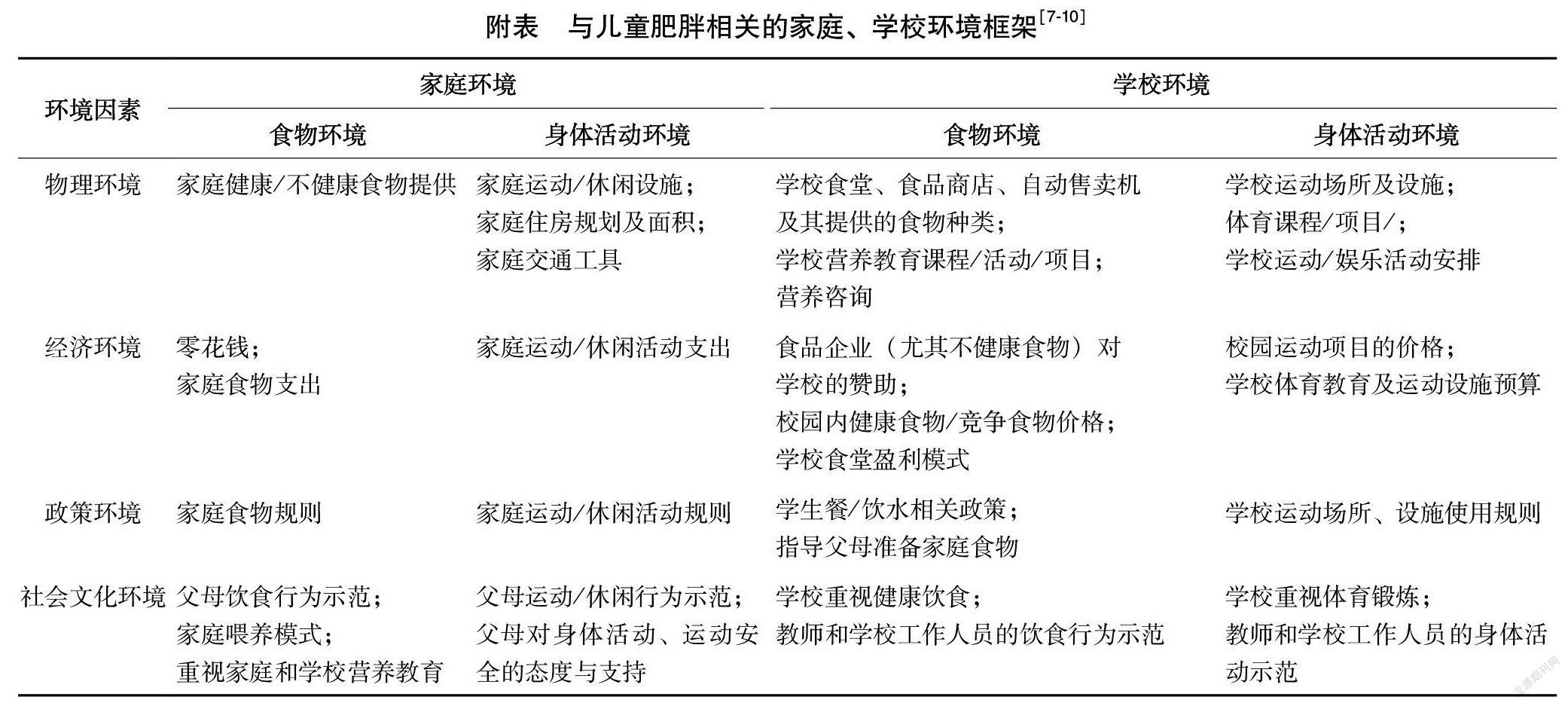家庭、學校環境與兒童肥胖
朱文麗 馬冠生

摘 要:兒童超重肥胖率在全球范圍內快速上升,已成為威脅兒童健康與發展的重要公共衛生問題。致肥胖環境是預防與控制兒童肥胖的可改變因素,包括食物環境和身體活動環境。作為兒童的主要活動場所,家庭和學校所提供的食物/運動設施、教育和咨詢服務、制定的食物/運動規則、行為示范作用、食物/運動相關的經濟因素等,均與兒童的食物選擇以及身體活動水平有關,并進一步影響兒童肥胖風險。既往關于家庭/學校環境與兒童肥胖的關系結論尚不一致,有必要進行現有證據分析和評價,為相關指南及政策的制定提供依據,并在下一步的研究中補充高質量的縱向研究設計,補充中國人群(尤其兒童)數據,并綜合考慮不同層次致肥胖環境與個體因素交互作用對行為和體重的影響。
關鍵詞:致肥胖環境;食物環境;身體活動環境;家庭環境;學校環境;兒童;肥胖
超重肥胖已成為當下主要的疾病負擔,幾乎所有國家和地區、所有年齡段的超重肥胖率都在快速上升,尤其兒童青少年人群。1975—2016年間,全球范圍內5~19歲兒童超重肥胖率從4%增加到18%[1]。目前,5歲以下、5~9歲、10~19歲兒童青少年的超重肥胖率分別為5.9%、20.6%、17.3%[2]。青少年的主要健康問題已從意外傷害轉變為非傳染性慢性疾病為主(45%國家/地區和33%青少年)[3]。我國全國學生體質與健康調研結果顯示,1985—2014年間,7~18歲學生超重、肥胖檢出率年均增長值分別為0.27%~0.63%、0.10%~0.58%,2014年超重肥胖率達到19.4%[4],高于全球平均水平。絕大多數兒童肥胖均為單純性肥胖,受個體(遺傳、行為、生理、心理、認知)、環境及其交互作用的影響,沒有任何一項單一的干預措施可以阻止日益增長的肥胖流行,成功應對兒童肥胖的挑戰需要考慮致肥胖環境和生命全過程的關鍵因素[5]。
1 致肥胖環境
致肥胖環境指導致高能量攝入和久坐少動行為的環境,包括食物選擇以及身體活動的機會,以及與食物和身體活動相關的社會規范[5];涵蓋政治(貿易協議、財政、農業政策和食物體系)、建成環境(社區食品商店/餐廳、身體活動相關設施的地理分布)、社會規范(體重和身體形象的社會范式、兒童喂養習俗、更高體重群體的階層、身體活動的社會限制)和家庭環境(家庭食品提供、家庭成員飲食行為和身體活動習慣)等。世界衛生組織(WHO)在《以人群為基礎預防兒童肥胖策略》中,首次提出了以人群為基礎控制兒童肥胖的綜合性策略性框架;其中在環境支持上,提及通過實施基于全人群的廣泛的政策和措施,包括法律法規、稅收和補貼、食品營銷等,創造促進健康的食物環境和身體活動環境[6]。
1999年,Swinburn提出致肥胖環境分析工具——與肥胖相關的環境分析框架(ANGELO),用來分析對食物選擇和身體活動存在潛在影響的環境因素[7-8]。ANGELO的基本框架是一個2×2×4的網格,將致肥胖環境分為了兩個方面(食物環境和身體活動環境)、兩個層次(微觀環境和宏觀環境)、四個維度(物理環境、經濟環境、政策環境、社會文化環境)。當今大部分兒童在鼓勵體重增加的致肥胖環境中長大,ANGELO框架為研究環境對兒童超重肥胖的影響提供了有效的分析工具。
1.1 食物環境和身體活動環境
食物環境是指食物從種植(養殖)、加工、包裝、儲存、運輸、銷售到消費等食物供應鏈各環節中,決定食物可提供性、可獲得性的物理環境和社會文化環境,如家庭食物環境、學校食物環境、社區食物環境、食物消費環境等。對兒童而言,家庭環境、學校環境、消費環境與食物提供的數量和質量(營養性和安全性)有關,而社區環境與食物的可獲得性有關。此外,食物環境還會影響個體的食物營養相關知識、信念和技能,以及進食情緒等,從而影響飲食行為和食物選擇。廣義的食物環境也包括宏觀政策環境和社會文化環境,如農業、貿易和財稅政策、食品標準、食品和飲料配方改進、食品和飲料銷售管理、媒體宣傳和廣告等。身體活動環境是指與個體身體活動密切相關的建成環境以及社會環境,主要指在一定地理空間范圍內能夠影響個體身體活動的城市規劃環境,包括土地利用類型、交通系統、建成環境設計特征等。社區建成環境包括公園、街道、操場、人行道等,這些場地能夠為兒童參與體力活動提供安全且低成本的運動環境,因此對于兒童身體活動促進具有重要作用。
1.2 微觀環境和宏觀環境
微觀環境是指一群人為了特定的目的而聚集在一起,這個環境可以進行飲食和(或)身體活動,例如家庭、學校等,環境空間相對較小,但與個體較密切。宏觀環境涵蓋與肥胖有關的設施、服務、政策和態度,如各級政府部門、食品工業、社會態度、信念等,宏觀環境空間較大,在很大程度上超出了個人的影響。有些宏觀環境具有強大的慣性,因此很難被改變,如由于利益關系,食品企業生產的不健康食品沒有得到有效控制。
1.3 物理環境和社會環境
物理環境是指在家庭、學校、社區、超市、餐廳、自動售賣機等可以獲得食物和/或身體活動機會的環境。經濟環境是指與身體活動或食物相關的成本。食品的價格受到食品生產、加工、銷售的影響,而這些又都受到市場的支配。政策環境是指與食物選擇和身體活動有關的規則,包括法律、法規、正式或非正式的政策、學校和家庭的規則等。社會文化環境包括態度、信念和價值觀,主要指家庭、學校、社區或社會對食物選擇和身體活動的態度、認知和價值觀,例如食物代表的意義、自我體型的感知等。
2 家庭環境與兒童肥胖
家庭是與兒童關系最密切的環境,兒童的飲食行為和身體活動大多發生在家里或與家庭成員一起完成,家庭提供的食物/運動設施、家庭支出、家庭規則以及父母行為示范等對于兒童肥胖相關行為(飲食行為、身體活動)的形成與發展,乃至體重狀況產生較大影響,這也可以在一定程度上解釋肥胖的家庭聚集現象。飲食行為通常具有一定的社會屬性,尤其對于5歲以下兒童,由于模仿能力較強,會觀察進食環境里的父母和其他成年人、同伴等的行為,從而影響他們的食物喜好以及飲食行為的形成及發展。此外,如父母過度的食物控制會導致兒童具有較少的自我控制的機會,還會擾亂兒童自身產生的饑餓和飽腹感的反應,進一步可能強化兒童對高脂肪高能量食物的偏好,影響兒童的能量平衡和食物攝入,且不利于兒童接受新的食物。依據ANGELO框架以及其他學者提出的家庭環境模型[7-10],與兒童肥胖相關的家庭食物環境和身體活動環境主要包括家庭食物供應、父母喂養模式、家庭飲食行為、家庭運動/休閑場所及設施,以及父母相關知識和技能(如烹飪技能、運動技能)、家庭社會人口學特征(經濟狀況、家庭構成、父母受教育程度、食物支出、運動/游戲支出)、家庭行為規則(食物規則、運動/休閑規則)、父母行為示范(飲食行為、運動/休閑行為)等(附表)。
大量研究表明,家庭提供高營養密度/低能量密度健康食物(如蔬菜水果)、減少提供高糖高脂肪高能量食物(如含糖飲料、油炸食品)、家庭有運動/休閑的場所和設施、家庭采用鼓勵型/支持型喂養模式、限制兒童選擇高脂肪高糖食物以及視頻時間、父母行為示范、家庭共餐、父母支持身體活動并與兒童共同參與等,均有利于兒童選擇健康食物、提高身體活動水平,降低肥胖風險[11-29]。但結論尚存在爭議,而且缺乏中國兒童相關數據。
3 學校環境與兒童肥胖
從學齡期開始,學校成為兒童飲食行為和身體活動的另一個重要場所。學生所需能量和營養素的1/3是在學校環境內攝入的,包括學生餐以及零食等競爭性食物,校園環境內是否提供這些食物對于學生的食物選擇非常重要。另一方面,兒童行為的自主性進一步增強,而且活動范圍增加,學校、同伴、老師、社區等對行為的影響增加。學齡期亦開始進入到了系統學習階段,通過健康教育等手段,可以改善兒童青少年的健康素養,進而糾正之前的危險行為(如不健康飲食行為和身體活動不足等),因此,也是預防與控制兒童肥胖的重要窗口期。
與兒童肥胖相關的學校環境主要包括學生在校園環境內可以獲得的食物(包括水)以及身體活動機會,如學校供餐、運動相關場所及設施等;其二是學生在學校內獲得的和食物營養/身體活動有關的信息,如教育與服務(營養教育、體育教育、健康咨詢、體格檢查)、政策(學生營養改善計劃,食物、運動相關管理規定)、教師和學校工作人員行為示范等多方面(附表)。學校實施營養健康相關政策(如學校午餐計劃、學生奶計劃、營養不良/超重兒童干預項目、貧困學生補助等),制定校園食品銷售管理規定(不以任何形式推銷高能量、高脂肪、高糖、高鹽的食品,包括贊助校內活動,食品店和自動售賣機不銷售碳酸飲料等)、教師和工作人員定期培訓制度、家庭經濟困難學生補助制度等,學校配置相關設施與設備(如學校食堂、飲水和洗手設備、運動場所等),提供相應的營養與健康服務,并開展健康教育活動(包括課程教育、實踐活動、小菜園、宣傳海報,以及家長課堂等),是有利于學生健康飲食行為和身體活動的[30-42]。尤其教育是學校非常重要的功能,在現有德智體美勞教育基礎上,需要增加適宜的食物營養教育,不僅對學生,也包括教師和學校工作人員,甚至家長、配餐企業等,而且需保證一定的教育時長(例如飲食行為的改變至少需要學時數為30~50小時/學年),但目前我國營養教育未得到應有的重視。由于學校環境是以群體為基礎的評價(家庭環境評價以個體為基礎),因此不太容易得到學校環境與兒童肥胖關系的直接證據。既往研究仍存在結論不一致、缺乏中國人群數據等問題。
4 下一步方向
4.1 現有證據評價
兒童肥胖已成為一個日趨嚴重的公共衛生問題。2008年,我國原衛生部疾控局發布了《中國學齡兒童少年超重和肥胖預防與控制指南》(試行),為指導兒童超重肥胖的預防與控制發揮了重要作用。《指南》試行距今已10余年,兒童肥胖的流行情況、影響因素、健康危害及干預策略都有所變化,原《指南》(試行)已不能適應現在的需要,因此有必要進行證據的補充與分析,為《指南》的修訂提供科學依據。致肥胖環境是近10年在兒童肥胖相關指南/政策中被愈加關注的可改變因素。但是,環境對體重的影響不易獲得直接證據,作為兒童密切接觸且對兒童行為影響最大的環境因素,家庭/學校環境與兒童食物選擇、身體活動、體重狀況的關系結論尚不一致,因此有必要按照規范的證據分析和評價程序,對家庭/學校環境與兒童肥胖的關系進行循證研究,為家庭、學校或其他利益相關者提供預防與控制,兒童肥胖的科學、有效措施,為相關指南和政策的制定提供依據,為研究人員提供下一步研究線索。
4.2 證據補充
總體來說,關于家庭/學校環境與兒童肥胖的研究尚處于早期階段,既往多為橫斷面研究,缺乏高質量的研究設計(如縱向隊列研究),且缺乏中國人群(尤其兒童)數據;行為(食物選擇和身體活動)是介于環境和肥胖之間的中間變量,應同時作為結局變量進行考察;作為兒童的主要活動場所,不僅是家庭和學校的內部環境,其周邊的社區環境,以及再遠一些的宏觀環境,對于兒童行為也有較大的影響,應綜合考慮不同層次致肥胖環境以及個體因素交互作用對行為和體重的影響。以上均需補充相關科學證據。
說明:本文作者為《兒童肥胖預防與控制指南(2021)》修訂委員會專家組及其團隊成員。《兒童肥胖預防與控制指南(2021)》修訂委員會是由國家衛生健康委疾控局委托、北京大學公共衛生學院牽頭成立,通過對關鍵問題進行循證,以循證結果為依據制定推薦意見并完成《兒童肥胖預防與控制指南(2021)》的撰寫。
參考文獻
[1]NCD Risk Factor Collaboration(NCD-RisC).Worldwide trends in body-mass index,underweight,overweight,and obesity from 1975 to 2016:a pooled analysis of 2416 population-based measurement studies in 128·9 million children,adolescents,and adults[J].Lancet,2017,390(10113):2627-2642.
[2]FAO,IFAD,UNICEF,WFP and WHO.The state of food security and nutrition in the world 2019.Safeguarding against economic slowdowns and downturns[M].United Nations,2019.
[3]Azzopardi PS,Hearps SJC,Francis KL,et al.Progress in adolescent health and wellbeing:tracking 12 headline indicators for 195 countries and territories,1990-2016[J].Lancet,2019,393(10176):1101-1118.
[4]王爍,董彥會,王政和,等.1985—2014年中國7~18歲學生超重與肥胖流行趨勢[J].中華預防醫學雜志,2017,51(4):300-305.
[5]WHO.Report of the commission on ending childhood obesity[EB/OL].Geneva:World Health Organisation,2016.
[6]WHO.Population-based approaches to childhood obesity prevention[EB/OL].Geneva:World Health Organisation,2012.
[7]Swinburn B,Egger G,Raza F.Dissecting obesogenic environments:the development and application of a framework for identifying and prioritizing environmental interventions for obesity[J].Prev Med,1999,29(6):563-570.
[8]WHO.Prioritizing areas for action in the field of population-based prevention of childhood obesity:a set of tools for Member States to determine and identify priority areas for action[EB/OL].Geneva:World Health Organisation,2012.
[9]Rendina D,Campanozzi A,De Filippo G.Methodological approach to the assessment of the obesogenic environment in children and adolescents:a review of the literature[J].Nutr Metab Cardiovasc Dis,2019,29(6):561-571.
[10]Rosenkranz R R,Dzewaltowski D A.Model of the home food environment pertaining to childhood obesity[J].Nutr Rev,2008,66(3):123-140.
[11]Couch S C,Glanz K,Zhou C,et al.Home food environment in relation to children’s diet quality and weight status[J].J Acad Nutr Diet,2014,114(10):1569-1579.
[12]郭春雷.中國7~17歲兒童青少年食物與致胖環境生態流行病學研究(2000~2011)[D].北京:中國疾病預防控制中心,2019.
[13]Grammer AC,Balantekin KN,Barch DM,et al.Parent-Child influences on child eating self-regulation and weight in early childhood:a systematic review[J].Appetite,2021(168):105733.
[14]Tomayko EJ,Tovar A,Fitzgerald N,et al.Parent involvement in diet or physical activity interventions to treat or prevent childhood obesity:an umbrella review[J].Nutrients,2021,13(9):3227.
[15]Suggs LS,Della Bella S,Rangelov N,et al.Is it better at home with my family? The effects of people and place on children’s eating behavior[J].Appetite,2018(121):111-118.
[16]Sokol RL,Qin B,Poti JM.Parenting styles and body mass index:a systematic review of prospective studies among children[J].Obes Rev,2017,18(3):281-292.
[17]Wang J,Fielding-Singh P.How food rules at home influence independent adolescent food choices[J].J Adolesc Health,2018,63(2):219-226.
[18]Skala K,Chuang RJ,Evans A,et al.Ethnic differences in the home food environment and parental food practices among families of low-income Hispanic and African-American preschoolers[J].J Immigr Minor Health,2012,14(6):1014-1022.
[19]Vollmer RL,Mobley AR.Parenting styles,feeding styles,and their influence on child obesogenic behaviors and body weight.A review[J].Appetite,2013(71):232-241.
[20]Sleddens EF,Gerards SM,Thijs C,et al.General parenting,childhood overweight and obesity-inducing behaviors:a review[J].Int J Pediatr Obes,2011,6(2):e12-27.
[21]Mihrshahi S,Drayton B A,Bauman A E,et al. Associations between childhood overweight,obesity,abdominal obesity and obesogenic behaviors and practices in Australian homes[J].BMC Public Health,2017,18(1):44.
[22]Flattum C,Draxten M,Horning M,et al.Home plus:Program design and implementation of a family-focused,community-based intervention to promote the frequency and healthfulness of family meals,reduce children’s sedentary behavior,and prevent obesity[J].Int J Behav Nutr Phys Act,2015(12):53.
[23]Quick V,Martin-Biggers J,Povis GA,et al.A socio-ecological examination of weight-related characteristics of the home environment and lifestyles of households with young children[J].Nutrients,2017,9(6):604.
[24]Van Grieken A,Renders CM,Van De Gaar VM,et al. Associations between the home environment and children’s sweet beverage consumption at 2-year follow-up:the‘Be active,eat right’study[J].Pediatr Obes,2015,10(2):126-133.
[25]Hayes JF,Balantekin KN,Conlon RPK,et al.Home and neighbourhood built environment features in family-based treatment for childhood obesity[J].Pediatr Obes,2019,14(3):e12477.
[26]Baur L A.Associations between the home food environment and obesity-promoting eating behaviors in adolescence[J].Obesity,2012,15(3):719-730.
[27]Santiago-Torres M,Adams A K,Carrel A L,et al.Home food availability,parental dietary intake,and familial eating habits influence the diet quality of urban Hispanic children[J].Child Obes,2014,10(5):408-415.
[28]Vepsalainen H,Mikkila V,Erkkola M,et al.Association between home and school food environments and dietary patterns among 9-11-year-old children in 12 countries[J].Int J Obes Suppl,2015,5(Suppl 2):S66-S73.
[29]Ong J X,Ullah S,Magarey A,et al.Relationship between the home environment and fruit and vegetable consumption in children aged 6-12 years:a systematic review[J].Public Health Nutr,2017,20(3):464-480.
[30]Park S,Choi BY,Wang Y,et al.School and neighborhood nutrition environment and their association with students’? nutrition behaviors and weight status in Seoul,South Korea[J].J Adolesc Health,2013,53(5):655-662.
[31]Nga VT,Dung VNT,Chu DT,et al.School education and childhood obesity:a systemic review[J].Diabetes Metab Syndr,2019,13(4):2495-2501.
[32]Cohen JFW,Hecht AA,McLoughlin GM,et al.Universal school meals and associations with student participation,attendance,academic performance,diet quality,food security,and body mass index:a systematic review[J].Nutrients,2021,13(3):911.
[33]de Medeiros GCBS,de Azevedo KPM,Garcia Dá,et al. Protocol for systematic reviews of school-based food and nutrition education intervention for adolescent health promotion:evidence mapping and syntheses[J].Medicine,2019,98(35):e16977.
[34]Doustmohammadian A,Omidvar N,Shakibazadeh E.School-? based interventions for promoting food and nutrition literacy(FNLIT)in elementary school children:a systematic review protocol[J].Syst Rev,2020,9(1):87.
[35]Martin A,Booth JN,Laird Y,et al.Physical activity,diet and other behavioural interventions for improving cognition and school achievement in children and adolescents with obesity or overweight[J].Cochrane Database Syst Rev,2018,1(1):CD009728.
[36]Micha R,Karageorgou D,Bakogianni I,et al. Effectiveness of school food environment policies on children’s dietary behaviors:a systematic review and meta-analysis[J].PLoS One,2018,13(3):e0194555.
[37]Ip P,Ho FK,Louie LH,et al.Childhood obesity and physical activity-friendly school environments[J].J Pediatr,2017(191):110-116.
[38]Li M,Xue H,Wen M,et al.Nutrition and physical activity related school environment/policy factors and child obesity in China:a nationally representative study of 8 573 students in 110 middle schools[J].Pediatr Obes,2017,12(6):485-493.
[39]Jia P,Li M,Xue H,et al.School environment and policies,child eating behavior and overweight/obesity in urban China:the childhood obesity study in China megacities[J].International Journal of Obesity,2017,41(5):813-819.
[40]Morton KL,Atkin AJ,Corder K,et al.The school environment and adolescent physical activity and sedentary behaviour:a mixed-studies systematic review[J].Obes Rev,2016,17(2):142-158.
[41]Gray HL,Buro AW,Barrera Ikan J,et al.School-level factors associated with obesity:a systematic review of longitudinal studies[J].Obes Rev,2019,20(7):1016-1032.
[42]Barnes C,McCrabb S,Stacey F,et al.Improving implementation of school-based healthy eating and physical activity policies,practices,and programs:a systematic review[J].Transl Behav Med,2021,11(7):1365-1410.
Family,School Environment and Childhood Obesity
ZHU Wen-li,MA Guan-sheng
(School of Public Health,Peking University Health Science Center,Beijing 100191,China)
Abstract:Childhood overweight is rising rapidly worldwide,especially in China,and has become an important public health problem threatening the health and development of children.Obesogenic environment is the modifiable factor for the prevention and control of childhood obesity,including food environment and physical activity environment.Family and school are the main living places of children,where availability and accessibility of food/exercise facilities,education and counselling services,food/exercise rules,and behavioral model were related with children’s food choice,physical activity,and obesity risk.Previous studies have not reached a consensus,and it would be necessary to analyze and evaluate existing evidences,to provide scientific basis for the guideline and policy development.Furtherly the high-quality longitudinal study would be designed,to comprehensively analyze the interaction of obesogenic environment of different levels and individual characteristics,especially in Chinese children.
Keywords:obesogenic environment;food environment;physical activity environment;family environment;school environment;children;obesity
基金項目:國家衛生健康委員會疾病預防控制局委托項目(2019)。
作者簡介:朱文麗(1973— ),女,教授,研究方向:兒童營養
通信作者:馬冠生(1963— ),男,教授,研究方向:學生營養、營養與慢性病。
3105500338287

